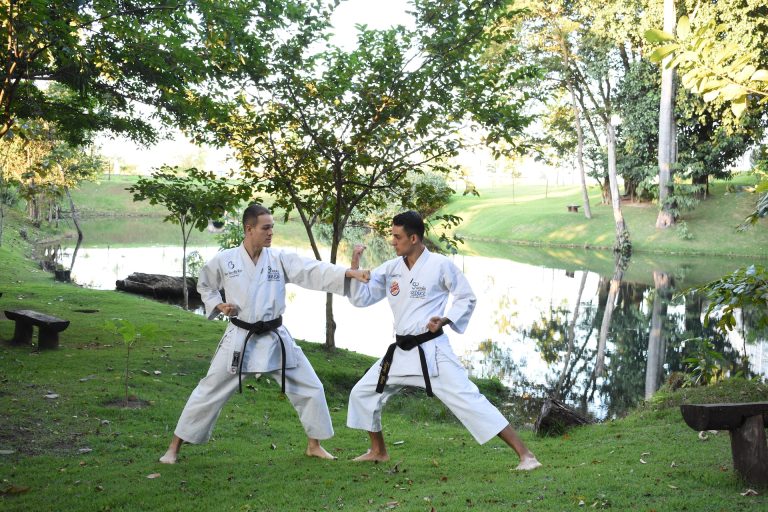What Colour Belts Are There in Karate?
Karate is a martial art that has a rich history of traditions and customs. One of the most recognizable symbols of karate is the belt system, which signifies the level of expertise a student has achieved. In this blog post, we’ll explore the different colour belts in karate, their significance, and what it takes to move up the ranks.
The Importance of the Belt System
The belt system is an essential aspect of karate as it not only represents skill levels but also the discipline and dedication required to progress through each level. The colours of the belts are a simple and effective way to show the progression of a student’s skills and knowledge.
White Belt
The white belt is the starting point for all karate students. It represents a blank canvas, symbolizing the beginner’s mind and humble spirit. Those who wear a white belt are just starting their training and have not yet learned the basic techniques and principles of karate.
Yellow Belt
The yellow belt signifies that the student has gained some knowledge of basic karate techniques. They have demonstrated the patience, perseverance, and mental fortitude necessary to advance beyond the beginner level. Students at this level typically have a basic understanding of basic kicks and punches and are starting to learn more advanced techniques.
Orange Belt
Those wearing an orange belt have shown significant improvement in their karate skills. At this level, students have a solid foundation in basic moves and are starting to learn more advanced techniques such as combinations or ‘kata’ (a sequence of moves). Orange belts are also expected to develop their spiritual aspects, including meditation, breathing techniques, and concentration.
Green Belt
The green belt signifies that the student has reached an intermediate level in their karate training. They have mastered the basic techniques and are now developing more complex combinations and sequences. Students at this level are also expected to be more disciplined and focused and to develop a strong sense of responsibility and leadership.
Blue Belt
A blue belt represents the student’s continued progress in their karate training. At this level, students are expected to have mastered most of the fundamental techniques and are now starting to learn advanced variations, spins and throws. They must also be able to perform the basic techniques with increased speed, power, and accuracy.
Purple Belt
The purple belt is a rare and significant achievement in karate. It represents mastery of basic techniques and a deep understanding of the principles of karate. Karate students at this level have demonstrated exceptional dedication, discipline, and skill. Purple belt holders may also be expected to teach or mentor other students.
Brown Belt
The brown belt is the highest rank before the black belt. It demonstrates the ability of the student to create and execute more complex techniques incorporating hand techniques, joint manipulation, and throws. Students at this level must also be able to demonstrate strong leadership skills and mentor lower-ranking students.
Black Belt
The black belt is the highest rank in karate and signifies the student’s mastery of the discipline. To attain a black belt, students must have spent years honing their skills and developing their mind, body and spirit. Those who hold a black belt are seen as experts in karate and are expected to lead by example, act with humility, and constantly strive to improve their skills.
What Colour Belts are there in Karate?
When it comes to martial arts, karate is one of the most popular disciplines out there. Karate is a striking-based martial art that originated in Okinawa, Japan. It has since spread across the world, becoming a staple in many gyms and dojos. One of the most common questions asked about karate is what colour belts are there? This question is often asked by beginners who are just starting their journey in karate. In this blog post, we will answer this question and provide some additional information about karate and its belt system.
What is the significance of belts in karate?
Belts in karate signify a student’s progress and level of expertise. The belt system was introduced in the early 20th century by Jigoro Kano, the founder of judo, and was later adopted by karate. As a student progresses through the different belt levels, they gain experience and knowledge in different techniques, forms, and philosophies of karate. Belts are a recognition of the efforts and skills a student has acquired throughout their training.
What are the different colour belts in karate?
Karate has a specific belt ranking system with various colours that represent different levels of proficiency. From beginner to advanced, the colours of the belts in karate are as follows:
– White Belt: This is the starting point for all karate students. It represents a beginner’s level of skill and knowledge.
– Yellow Belt: After achieving the white belt level, students progress to the yellow belt. Here, students have a basic understanding of karate techniques.
– Orange Belt: The Orange belt signifies further progress in the student’s karate journey. Students at this level should have a better understanding of karate techniques and should have more knowledge of katas.
– Green Belt: The Green belt is a significant stage in karate training, demonstrating that the student is making good progress in their training, and their skills are improving.
– Blue Belt: The Blue Belt is a rare belt in karate, and it denotes that the student is becoming an expert in karate techniques and philosophy.
– Purple Belt: The Purple Belt shows that the student has gained an advanced level of knowledge in karate techniques as well as discipline and a strong mindset.
– Brown Belt: The Brown Belt is a high level in karate training, only attainable by the most devoted students. Students at this level have strong technical skills and advanced knowledge of kata.
– Black Belt: The ultimate goals for most karate practitioners are to achieve a Black Belt level. The Black Belt represents mastery of karate techniques and its philosophy.
What is the process of getting a higher belt?
To advance to the next karate belt level, students need to be enrolled in a karate school or gym, be diligent in studying, and show proficiency in executing the techniques they learned. The karate student undergoes different tests, functionality assessments, and challenges to determine their readiness to graduate to the next level. Each karate gym or school may have different criteria for advancement, testing, and evaluation. Generally, students have to show their abilities in katas, sparring, breaking techniques and demonstrate knowledge of karate philosophies to graduate to a new belt level.
What are the different colour belts in karate?
Karate is a popular martial art that has been practiced for centuries. It is characterized by a variety of techniques including strikes, kicks, and blocks. Karate practitioners advance through different levels of skill by earning a series of coloured belts. But, what colour belts are there in karate, and how can you earn them? In this article, we’ll explore the different colour belts in karate and what it takes to earn them.
White Belt
The journey to earning your first coloured belt in karate starts with the white belt, which represents a beginner or novice practitioner. A white belt signifies the beginning of the student’s journey to learn karate. During this stage of training, the focus is on basic moves such as punches, kicks, and blocks. Students are also expected to learn basic terminology used in karate such as the names of the techniques and different parts of the body.
Yellow Belt
The second belt in karate is the yellow belt. In order to earn the yellow belt, students must demonstrate that they have gained a mastery of the basic techniques learned during the white belt stage. During this stage of training, students are required to learn more advanced techniques such as sweeps and throws. Students must also demonstrate the ability to execute combinations of basic moves.
Orange Belt
Once a student has earned their yellow belt, they can advance to the orange belt. This belt represents a significant step forward in the student’s journey in karate. To be awarded the orange belt, students must show a dedicated commitment to their karate practice. During this stage of training, students will be introduced to more complex techniques such as joint locks and grappling.
Green Belt
The green belt is the fourth belt in karate, and it represents a significant step up in skill level. In order to earn this belt, students must demonstrate proficiency in all techniques learned previously as well as show an understanding of the more advanced techniques learned during the orange belt stage.
Blue Belt
After earning the green belt, students advance to the blue belt, which represents a high level of skill and dedication to the practice of karate. During this stage, students are expected to continue honing their skills and expanding their knowledge of advanced techniques.
Purple Belt
The sixth belt in karate is the purple belt. To earn it, students must demonstrate a high degree of proficiency and skill in all techniques learned during previous stages. They must also be able to execute advanced techniques such as jumping kicks and spinning kicks with accuracy and control.
Brown Belt
The brown belt is the seventh belt in karate, and represents a high level of skill and dedication. At this stage of training, students are expected to show mastery of all techniques learned previously as well as mastery of advanced techniques such as throws and strikes. Brown belts are held in high regard in the karate community and are considered to be expert practitioners.
Black Belt
The black belt is the ultimate goal for many karate students. It represents the highest level of skill and dedication in karate. Earning a black belt requires years of dedication and hard work. Students must demonstrate mastery of all techniques learned previously as well as advanced techniques including weapons techniques. Each school has its own criteria for awarding black belts, but generally, students must meet a variety of requirements including age, time spent training, and successful completion of a rigorous exam.
Conclusion
Karate is a challenging and rewarding martial art that requires discipline, dedication, and hard work. The different colour belts in karate provide a clear path for students to progress through various skill levels. Each belt represents a significant step forward in the student’s journey towards mastery of the art. By understanding the requirements for obtaining each belt, students can set clear goals and measure their progress along the way. With hard work and perseverance, anyone can become a skilled and dedicated participant in the karate community.
Inhaltsverzeichnis






